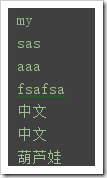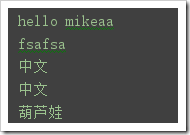打开文件:
在python3中,打开文件的函数是:
open(file, mode='r', buffering=None, encoding=None, errors=None, newline=None, closefd=True)
参数说明:
file--文件名
mode—打开模式,默认只读模式
buffering--如果buffering的值被设为0,就不会有寄存。如果buffering的值取1,访问文件时会寄存行。如果将buffering的值设为大于1的整数,表明了这就是的寄存区的缓冲大小。如果取负值,寄存区的缓冲大小则为系统默认。
encoding—打开文件的编码方式
模式介绍:
r:只读模式(默认)
w :只写模式,如果文件不存在就创建,如果存在,写入的数据会覆盖原来的数据
b :二进制模式
t :文本模式
+:可写可读模式
a:追加模式,如果文件存在则文件指针指向文件末尾(追加数据),如果不存在就创建
r+:读追加模式,先读,再追加
w+:写读模式,先写,意味着原本内容丢失,再读。
- 如果对于含有非ascll字符的文件,必须使用encoding,否则会抛异常:
print("r".center(50,'-')) f=open("file.txt",encoding="utf-8") print(f.read()) f.close() ----------------- 运行结果: my sas aaa fsafsa 中文 中文 葫芦娃
文件使用完毕后必须关闭: 文件指针.close()
文件操作:
读操作:
读取文件内容如下:
- reads()是读出全部内容
print("r".center(50,'-')) f=open("file.txt",encoding="utf-8") print(f.read()) f.close() --------------------------- 运行结果: my sas aaa fsafsa 中文 中文 葫芦娃
- readline()是读出一行
print("r".center(50,'-')) f=open("file.txt",encoding="utf-8") print(f.readline()) f.close() ----------- 运行结果: my
- readlines()是读出全部内容,并整理成一个列表
print("r".center(50,'-')) f=open("file.txt",encoding="utf-8") print(f.readlines()) f.close() ------------------------r------------------------- 运行结果: ['my ', 'sas ', 'aaa ', 'fsafsa ', '中文 ', '中文 ', '葫芦娃 ', ' ']
- r+模式会根据读的内容来决定指针的位置
print("r".center(50,'-')) f=open("file.txt","r+",encoding="utf-8") # print(f.readline()) f.write("hello mike") f.close()
结果:
print("r".center(50,'-')) f=open("file.txt","r+",encoding="utf-8") print(f.readline()) f.write("hello mike") f.close()
新结果:
写操作:
- write():将一个字符串写入文件
myfile=open("myfile1","wb") myfile.write(b"nnnnnn") myfile.write("my葫芦娃".encode("utf-8")) myfile.close()
- writelines(可迭代对象) 将一个可迭代对象写入文件
myfile=open("myfile1","wb") myfile.write(b"nnnnnn") myfile.writelines([b'1',b'2',b'3',b'4']) myfile.close()
- 当需要写完之后即时读出来时,使用w+,然后将文件指针置回文件头:
myfile=open("myfile1","wb+") myfile.write(b"nnnnnn") myfile.seek(0) print(myfile.read()) myfile.close()
- 如果是需要读出特定位置,可以使用变量来记录位置
myfile=open("myfile1","wb+") myfile.write(b"1nnnnnn") site=myfile.tell() myfile.write(b"2nnnnnn") myfile.seek(site)##读出后一段 print(myfile.read()) myfile.close()
with:
- 为了便捷的关闭文件,python增加了with功能,当with体执行完将自动关闭打开的文件:
with open("file.txt","r+",encoding="utf-8") as f:##将自动执行f.close() print(f.tell()) f.write("金刚") for line in f: print(line,end="")
- 可以同时打开多个文件:
with open("file.txt",'r') as f , open("file.new",'r') as m: print(f.read(),m.read())
文件常用函数:
file.close():关闭文件。关闭后文件不能再进行读写操作
file.seek(offset[, whence]):设置文件当前位置
file.tell():返回文件当前位置。
myfile=open("myfile1","wb+") myfile.write(b"1nnnnnn") site=myfile.tell() myfile.write(b"2nnnnnn") myfile.seek(site)##读出后一段 print(myfile.read()) myfile.close()
file.flush():刷新文件内部缓冲,立即把内部缓冲区的数据写入文件,因为并不是马上将文件
import time myfile=open("myfile1","wb+") myfile.write(b"1nnnnnn") time.sleep(10) # myfile.flush() myfile.write(b"2nnnnnn") myfile.close()
上述代码,直到程序运行完成才一次性写入“1nnnnnn2nnnnnn”
import time myfile=open("myfile1","wb+") myfile.write(b"1nnnnnn") myfile.flush() time.sleep(10) myfile.write(b"2nnnnnn") myfile.close()
上述代码,可以看到,在程序sleep之前就已经写入了“1nnnnnn”
file.truncate([size]):截取文件,从文件开头,截到指定位置,会覆盖原文件。
文件内容:
print("r".center(50,'-')) f=open("file.txt","r+",encoding="utf-8") print(f.readline()) print("----truncate()-------") print(f.tell()) m=f.tell() f.truncate(m)#内容从0位置截断到指定位置,不论当前光标位置 f.close()
执行后,文件内容:



